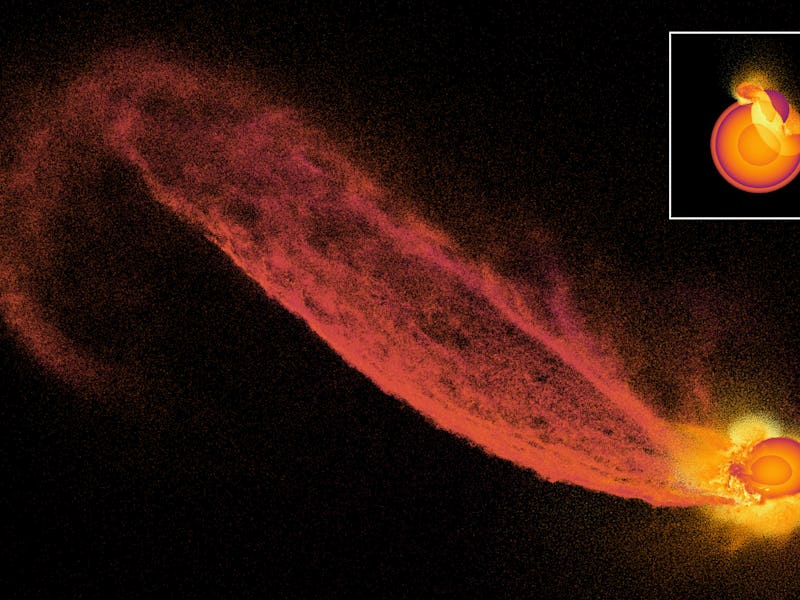Moon’s origin story may hold clues to a critical moment in Earth's history
In the collision thought to have formed our natural satellite, 10-60 percent of our planet's atmosphere may have been lost.

Around 4.5 billion years ago, the Solar System formed in the midst of the chaos of an early universe. As objects flung through the eddies of space, our own planet survived several massive impacts.
One such collision may have birthed the Moon, but not without a cost to Earth. In a recent study recreating the Earth's early history and the Moon's birth, scientists reveal that the collision may have also caused Earth to lose somewhere between 10 to 60 percent of its atmosphere.
The study was published Wednesday in the Astrophysical Journal Letters. The findings shed light on how these cosmic collisions affect the atmospheres of planets — and influence their habitability.
The researchers behind the new study ran more than 300 computer simulations of massive object collisions with rocky planets with thin atmospheres like Earth. They factored in the angle at which the objects hit the planet, the speed of the impact, as well as the size and mass of the colliding object.
A simulation showing the giant impact that may have formed the Moon, and caused Earth to lose a portion of its atmosphere.
"The puzzle about how the Moon formed and the other consequences of a giant collision with the early Earth is something that scientists are working hard to unravel," Jacob Kegerreis, a researcher at the Institute for Computational Cosmology, Durham University, and lead author of the study, said in a statement. "“We ran hundreds of different scenarios for many different colliding planets, showing the varying impacts and effects on a planet’s atmosphere."
Previous research suggested impact collisions during the late stages of a planet's formation period can affect its atmosphere.
Expanding on this idea, the new study found that following the impact which created the Moon, the Earth lost a significant portion of its atmosphere.
How did the Moon form? — Scientists believe that around 4 billion years ago a massive object the size of Mars, dubbed Theia, collided with a young, developing Earth, also called the proto-Earth. The collision tossed vaporized particles from the Earth into space, which were then bound together through gravity to form the Moon.
The impact hypothesis is one of three key theories of how the Moon formed. The others suggest the Moon was either formed at the same time as Earth, or that it was captured by Earth's gravitational field.
“While these computer simulations don’t directly tell us how the Moon came to be, the effects on the Earth’s atmosphere could be used to narrow down the different ways it might have been formed and lead us closer to understanding the origin of our nearest celestial neighbor," Kegerreis said.
The study not only gives scientists new insight on how the Moon may have formed, but also details a new way to study how similar collisions lead to loss of atmosphere of young, rocky planets.
Through their different simulations, the researchers found these impacts can have different consequences on the fate of a planet's atmosphere depending on the size of the colliding object, whether it is made of iron, rock, or both, and the angle at which it crashes into the planet.
The collisions could also lead to significant atmospheric gains if the colliding object also has a thick atmosphere, according to the study. On the other hand, the impact may precipitate the total obliteration of a planet's atmosphere.
The atmosphere of a planet greatly affects its habitability. It is one of the main factors scientists look for when observing planets other than Earth to determine whether or not they could potentially host life.
A planet’s atmosphere needs to be thick enough to transfer heat and offer insulation. If the Earth didn’t have its atmosphere, for example, the temperature at the surface would reach as low as -20 degrees Celsius.
So while chaotic, the objects which collided with a young Earth had a major, lasting effect on life as we know it.
Abstract: We present a new scaling law to predict the loss of atmosphere from planetary collisions for any speed, angle, impactor mass, target mass, and body composition, in the regime of giant impacts onto broadly terrestrial planets with relatively thin atmospheres. To this end, we examine the erosion caused by a wide range of impacts, using 3D smoothed particle hydrodynamics simulations with sufficiently high resolution to directly model the fate of low-mass atmospheres around 1% of the target's mass. Different collision scenarios lead to extremely different behaviors and consequences for the planets. In spite of this complexity, the fraction of lost atmosphere is fitted well by a power law. Scaling is independent of the system mass for a constant impactor mass ratio. Slow atmosphere-hosting impactors can also deliver a significant mass of atmosphere, but always accompanied by larger proportions of their mantle and core. Different Moon-forming impact hypotheses suggest that around 10%–60% of a primordial atmosphere could have been removed directly, depending on the scenario. We find no evident departure from the scaling trends at the extremes of the parameters explored. The scaling law can be incorporated readily into models of planet formation.
This article was originally published on